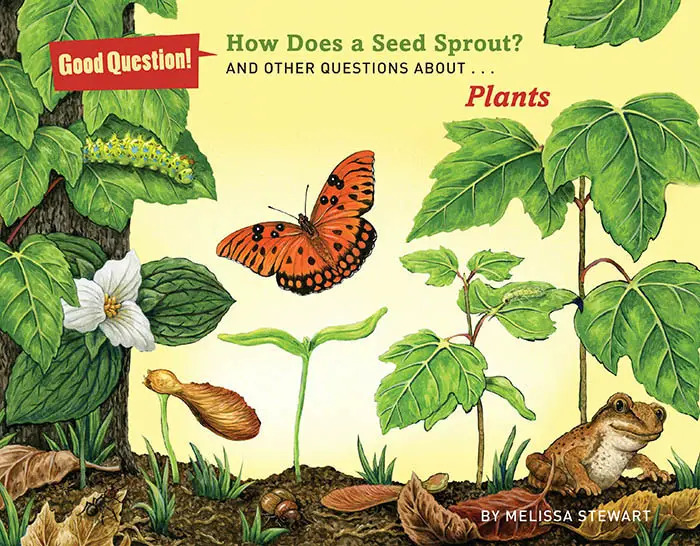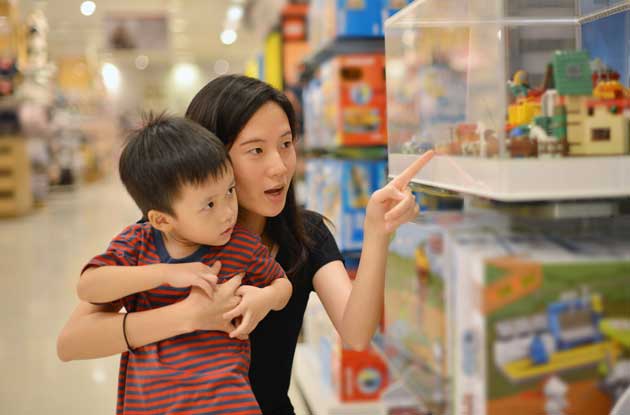Whether you want to start growing your own produce or your child has expressed interested in digging in the soil, we’ve compiled a list of 17 ways to a grow a green thumb, including gardening activities for kids, gardening tools for kids, what to plant in a kid’s garden, how to create small container gardens, and how to start composting.
1. Stimulate the senses with the top 20 plants for kids.
In addition to being a fruitful hobby, gardening has health benefits for kids and adults. Gardening outside promotes movement (walking, squatting, and lifting), and you’ll get plenty of vitamin D—just remember to wear sunscreen! It also “connects us with nature, which has been shown to work wonders for children having a hard time focusing,” says Renata Fossen Brown in Gardening Lab for Kids: 52 Fun Experiments to Learn, Grow, Harvest, Make, Play, and Enjoy Your Garden. Gardening can be therapeutic, and it stimulates all five senses, which is beneficial for many children with special needs.
The following 20 plants are ideal in children’s gardens because “they have personality, fragrance, texture, and color—vibrant color. They grow quickly—something kids need in response to their work,” says Sharon Lovejoy in her book Roots Shoots Buckets & Boots: pumpkins, sunflowers, gourds, corn, berries, hollyhocks, carrots, mimosa, poppies, tomatoes, trees, alliums, potatoes, woolly lamb’s ear, four-o’clocks, evening primroses, radishes, nasturtium, moon plant, and lemon verbena. Learn why Lovejoy chose these plants for children, and how your kids can incorporate them in their everyday life.
2. Create a galoshes garden.
Has your tot outgrown his favorite puddle jumpers? Don’t give them away; make them into a pair of mini gardens!
Materials:
|
Directions:
| 1. Drill drainage holes in the soles of the boots, and lay nylon screening inside boots to cover the holes. 2. Fill boots with soil and plant seedlings. 3. Place boots in a spot that receives 4 to 6 hours of sunlight daily. 4. To see if your mini gardens need water, push your finger into the soil and water plants if soil feels dry. |
We discovered this idea in Roots Shoots Buckets & Boots by Sharon Lovejoy, a font of unique family gardening suggestions and helpful tips.
3. Equip your tot with his own tools.
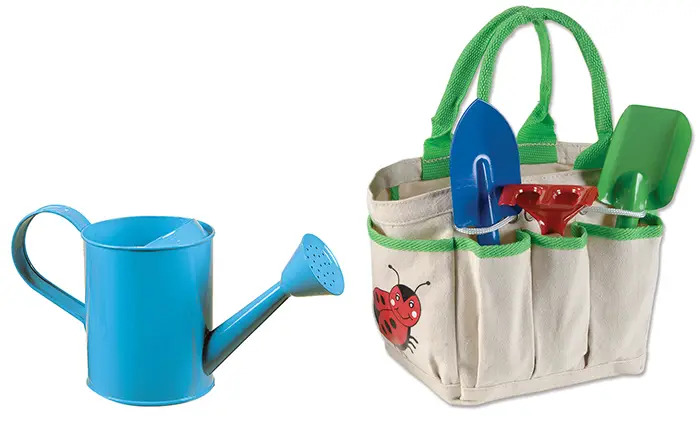 |
| The Garden Tote & Tools and Metal Watering Can from For Small Hands are designed with small gardeners in mind. The canvas garden tote is roomy enough for tools, seed packets, gloves, and anything else a gardener may need and comes with a spade, rake, and trowel. Plus, when your children grow out of the tote and watering can, you can turn them into small container gardens—just like their out-grown boots! |
4. Become a guerrilla gardener.
If you’re too impatient to tend to a garden, or don’t have a plot of land to call your own, here’s a thought: Toss seed grenades! First used centuries ago by farmers to ensure their precious seeds were protected from birds, insects, sun, and wind until rainfall caused them to germinate, these blooming bombs were most recently utilized by guerrilla gardening pioneer Liz Christy, who threw wildflower seed grenades into fenced-off vacant lots around her New York neighborhood.
5. Relish in your family’s lush garden.
To ensure gardening is a successful and enjoyable experience for your children, keep these tips in mind.
6. Grow a grassy garden gnome.
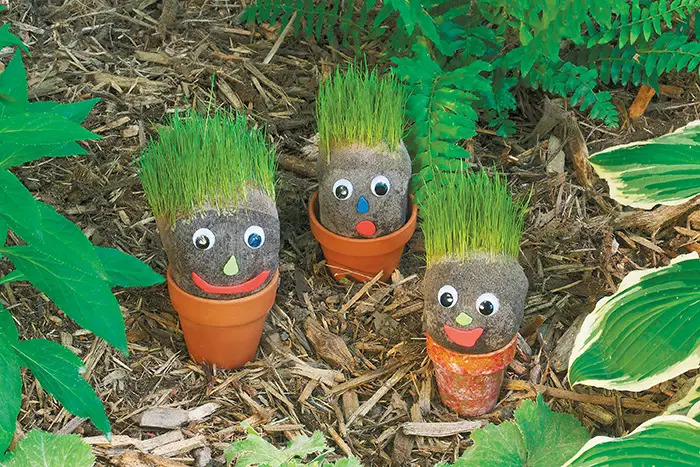
Fill your garden with gnomes—with actual growing hair!—to help watch over it and keep you company. |
7. Satisfy your child’s curiosity.
|
Ever wonder which part of a plant grows first, what’s a plant’s secret weapon, or why some flowers smell bad? How Does a Seed Sprout? and Other Questions About Plants by Melissa Stewart, one of the newest titles in the Good Question series, answers these questions and more. The book, which is aligned with the Common Core standards, gives children basic information in a Q-and-A format with detailed illustrations and plant lifecycle infographics. (Ages 7 and older) |
8. Get crafty.
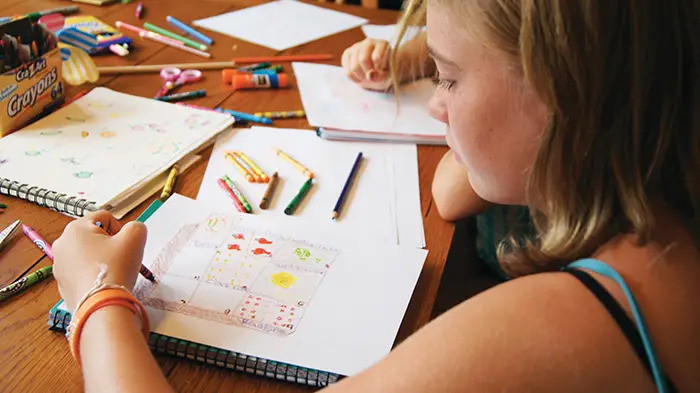 Shantlee Hope Sutch |
| Encourage your kids to participate in garden planning by having them create a garden map using markers, crayons, the computer, or collage. |
9. Keep your pets safe!
Some plants you may be considering for your garden could be toxic to cats and dogs. Keep indoor plants out of reach of your animals, and put a fence around your outdoor garden. Check out ASPCA’s list of plants that are toxic and nontoxic to cats and dogs to see which you should avoid.
10. Invite the fairies.
Did you know that fairy gardens are a thing? Search Pinterest and you’ll be tickled by the magic they can bring to your plants—and we’re willing to bet your princess and Peter Pan fans’ interest will be piqued, too. Browse at myfairygardens.com for ideas and accessories to help you create miniature whimsical landscapes using small-scale plants.
11. Go beyond your homemade snack.
Take one sunflower seed leftover from the Sunflower Oat Bars recipe and plant it in a little pot (a yogurt container is perfect) filled with compost, suggests Paul Lindley in his new book Ella’s Kitchen: The Big Baking Book. Ask your little one to cover the pot with plastic wrap and make a few holes in the top. Leave the pot on a sunny windowsill and when the first leaves appear, replant the sunflower in a bigger pot and leave it somewhere sunny outside. How tall will your sunflower grow?
12. Watch a seed germinate.
Place a damp paper towel in a clear plastic sandwich bag, then place a lima bean seed between the paper towel and bag. Put the bag on a windowsill that gets a lot of sunlight so the germination process can occur. Over the next several days, you’ll be able to observe how a seed grows for yourself. Put a reminder in your smartphone for next year: If you do this next spring too, you can plant the germinated seed in your garden!
13. Get inspired!
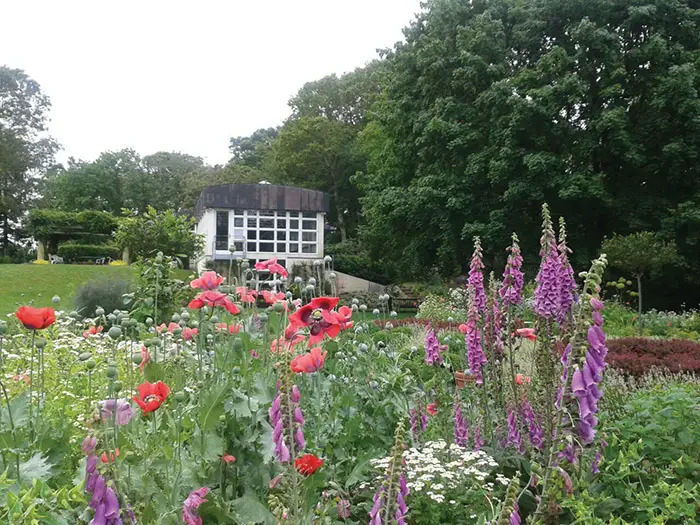 Courtesy Peconic Land Trust/Bridge Gardens |
| Bridge Gardens, a 5-acre public garden in Bridgehampton, is part of the Peconic Land Trust and includes many specimens of trees, hedgerow, flowers, and herbs. |
Need some inspiration for what to plant in your garden, or simply like to stroll through someone else’s? See our botanical garden where-to guide to find local gardens to visit.
14. Plant a salsa garden.
A patch of constant sun and a few pots are all you need to cultivate the main ingredients for some healthy nacho fixin’s. Pick up one each of cilantro, tomato, bell pepper, and jalapeño pepper plants at a nursery and repot them in organic soil. When it’s harvest time, plan a Tex-Mex dinner and tap the kids to help prepare—and see whose salsa recipe gets scooped up first!
15. Record your garden’s growth.
Have your child keep a journal about your garden filled with drawings of insects and plants, and observations about what they see.
16. Eat what you sow!
17. Make your own soil.
Is a lack of yard space keeping you from your composting goal? The All Seasons Indoor Composter is an in-house system of Bokashi composting that turns kitchen scraps into organic compost without the foul odor and can easily be stored in the cabinet under the sink. Each time you add food waste to the bin, top it with Bokashi (a mixture of water, wheat bran, and molasses), and the food will ferment more quickly than traditional composting. The composter also features a strainer and spigot, allowing the moisture released during the composting process to be drained and used as a nutrient-rich fertilizer for indoor and outdoor plants.
|
Main photo: While harvesting the fruits of your labor is an enjoyable aspect of gardening, spending time with your kids outside is perhaps the most important.
Paul Markert











